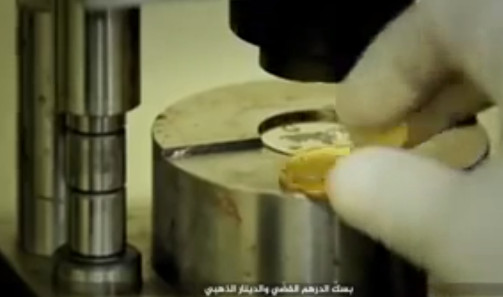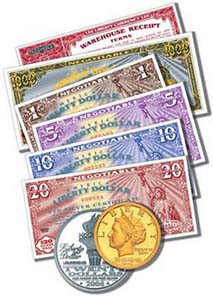by Ursula Kampmann
translated by Annika Backe
September 24, 2015 – As could be read everywhere in the media, the Islamic State has decided to issue its own currency and has thus started to mint coins. What is special about this is that the terror organization actually returns to the pre-WWI currency situation. The purchasing power of ISIS coins is based on their intrinsic value. The 5 dinar piece contains 4.25 grams of gold, thus equaling about 750 euros according to the current gold price. The lowest-denominated coin contains 10 grams of copper, which corresponds to a material value of roughly 5 cents.
ISIS video on YouTube: the minting of the gold dinar.
Ancient minting technology
Before the first coin was being struck, economists have already speculated whether or not ISIS would become dependent on the world gold price. But the problem lies elsewhere. The minting machine, with which the terror organization plans to produce the gold dinars, to supply hundreds of thousands of Muslims, is as old as the hills and certainly not suitable for modern mass minting. The alleged mintage of the machine, which is said to have been smuggled from Italy, is 5,000 coins a day only. It is clear to see: the dinar is a clever PR stunt, and it is not a new one.
The Kelantanese dinar. Photograph: Wikipedia.
The new Islamic dinar and the dinar of Kelantan
Provoking considerable less media response, the government of the Malaysian state of Kelantan, ruled by the Islamic Party of Malaysia since 1990, has commissioned the World Islamic Mint of Abu Dhabi with releasing legal tender that is based on the gold standard, the so-called Kelantanese dinar. The government had already made good experience with a currency made of gold. The first coins were issued in 2006 and were welcomed enthusiastically by the people. The currency sold out immediately, despite the central government in Kuala Lumpur instantly declaring the Malaysian ringgit the only legal tender in Kelantan, against the backdrop that the Malaysian Constitution forbids the individual states to mint their own coins. That, however, did not hinder the local government. The coins produced by the World Islamic Mint are currently being sold. Furthermore, in 2010, the zakat, a fee for the poor every Muslim is obliged to pay, was ostentatiously collected in the new dinars and dirhams.
Promotion photo for the liberty dollar.
United in matters of gold: conservative Islamic forces and the Western world
Kelantan is no isolated case. Not only conservative Islamic circles adhere to the idea that the Fall of Western money started with the complete detachment from the gold standard. US states like Louisiana, Oklahoma, Texas and Utah are likewise accepting gold and silver as legal tender. And to put an end to the success story of the liberty dollar created by Bernard von NotHaus, it took a court verdict.
What makes this idea rather dangerous is most likely the fact that it is evident to every economical housefather: if a state can only spend money whose purchasing power corresponds to the value stated on the coin or the banknote, then the central bank can no longer incur unlimited amounts of debt in advance. With all modern states issuing options on the future, a breakthrough of the Islamic currency would be the end of the modern Western economic system as we know it.
Portrait of Sir Thomas Gresham. Rijksmuseum Amsterdam. Source: Wikipedia.
Gresham’s Law or why the gold dinar is destined to fail
It is highly unlikely, however, that the gold dinar will actually drive out other currencies of the market. The reason is an economic principle that was stated as early as late Medieval Times. The law was named after Sir Thomas Gresham (1519-1579) who advised the English kings and queens, starting with Henry VIII, in matters of economics. The law should be well-known in the Islamic world, for it had been first formulated by the Egyptian Muslim Al-Maqrizi.
The basic statement of the principle is that bad money, hence debased or fiat money drives out good money, hence money that is based on the gold standard.
If a customer intends to spend money and is given the choice between two currencies, he would always favor the currency with the lower intrinsic value.
A case in point is the hundreds of thousands of coin albums, which are still hoarded by families in Switzerland, for they feature francs that contain silver. Another example is the German 10 euro as well as the 20 euro commemorative coin that banks exchange at nominal value. Although the silver price is far below the material value, these coins are nevertheless privately hoarded, even by people who have no explicit interest in coin collecting.
Further examples could easily be provided. But one thing becomes apparent. Anybody who will get his hands on an Islamic gold dinar will not spend it but keep it. Just like all the krugerrands, philharmonics and maple leafs that have been bought in large quantities in the aftermath of the financial crisis by people who surely do not link the present monetary system to religious issues.
Let us summarize: as circulating coin, the Islamic dinar has no future. It might have a future, on the other hand, as a coin to hoard, in the same way as all the other bullion coins currently released by a number of states.
In order to compete with these, however, ISIS would have to buy a few state-of-the-art minting machines.
Please read more about Gresham’s Law on Wikipedia.
Media throughout the world are providing images of the recently released ISIS coins.
A lot of reactions to the Islamic State minting coins can be found on YouTube.
We reported on the liberty dollar more than once: here and here.








